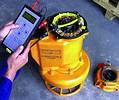

With the introduction of modern electronics, advances in electrical analysis and a better understanding of basic electromagnetic circuits, methods have been developed to measure the static electrical and electromagnetic properties of rotating machinery. An EPRI study shows that 47% of electric motor failures are due to electrical problems whereof 37% are due to coil and 10% to rotor failures. The All-Test IV Pro 2000 circuit analyser provides a unique method for immediately determining or trending electrical failures.
The instruments offer repeatable, accurate measurements which are easy to analyse. Motors from small fractional horsepower to over 10 000 hp (13,8 kV) have been tested successfuloly. The payback of the All-Test can be immediate, often achieved with early detection of the very first failing electric motor.
Detecting unbalanced phases using impedance
The importance of utilising motors with balanced impedance cannot be overstated. We all know that unbalanced voltage will increase motor temperature dramatically. Unbalanced impedance due to poor connections and improper winding techniques will affect operating temperature and reliability in the same way as incoming voltage. This greatly affects the longevity of the motor and the operating cost. For example, a 5% unbalance can cut the life of a motor in as much as half and increase trhe operating cost by thousands of rands per year for a 75 kW motor.
Good and bad rotor
The following sample is taken from readings using inductance in 12 testing positions of a 150 kW motor. The rotor defect was determined to be either a casting void or broken rotor bar which was confirmed on a dynamometer with vibration testing.
+500 motors can be stored in instrument
Users can store model number, motor size, date and time of test with their test rlesults, compare results from previous entries either in automatic mode or manual and look up motor by model number, previous test results or stored references. The instrument is a collector as well as an analyser. It can be used as a standalone collector and analyser or to download the information to a PC for long-term trending and easy report writing.
In the automatic mode test results are automatically compared with previously recorded references. This gives an instant reading of the percent of change in each phase from last entry. By the push of a button, the user can also call up the actual reading in engineering units. The tests performed in automatic mode are: resistance, impedance, phase angle, inductance and insulation to ground. The impedance test gives a 'good/bad' turn-to-turn reading by using the current/frequency relation method. The instrument performs the tests in approximately 15 to 20 s. When using manual mode the operator chooses the parameters - and capacitance measurement is also available. When testing (Z) impedance in manual, the instrument shows at what frequency (Hz) the test is performed.
Easy to operate
Persons with little knowledge or experience with testing can easily perform the tests and record the results. The instrument screen indicates in plain English how to proceed and what steps to follow. No need to disconnect power cables. No need to interpret waveforms. The All-Test IV Pro 2000 can be used for testing single and three-phase transformers.
Remote testing
The tests can be performed through several hundred feet of power cable making it easy to test even 'hard-to-reach' motors. Most testing can be performed from the control panel. All tests are performed with the electricity turned off. An audible and visual warning is issued if the instrument detects 30 V or more on-line. The tests are nondestructive and will not shorten life of windings with each test.
Lightweight and handheld, the unit weighs under 800 g. A port is provided on the instrument for uploading test results to a PC for long-term trending, analysis and printouts. Downloading information from PC to the All-Test is easily performed.
Instralec
(031) 702 9964
© Technews Publishing (Pty) Ltd | All Rights Reserved